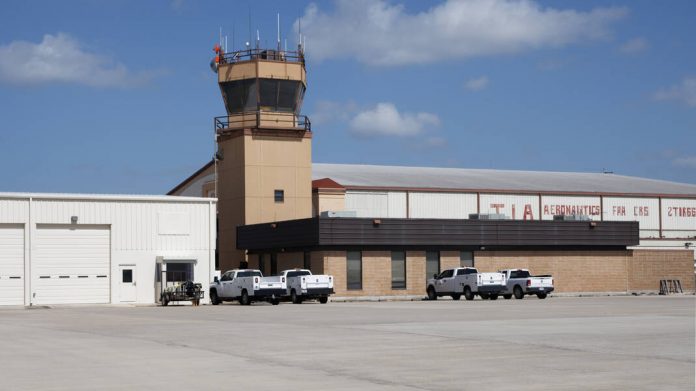
Rick Kelley/Valley Morning Star
A replacement air traffic control tower at VIA, if approved, will be built directly on the spot the current tower sits after it is demolished.
HARLINGEN — The air traffic control tower at Valley International Airport, a 51-year-old rust bucket which has not weathered well in the Valley climate, is facing being replaced.
Airport officials are looking for Federal Aviation Administration funding for a new tower, one that will stand about twice as high as the current structure, which is about 60 feet tall.
“When you’re up there looking, our airfield is so wide it’s almost a mile across, it’s almost like you’re looking right at the horizon,” said Bryan Wren, assistant director of aviation at VIA. “The control towers really need to see the runway hold position markings on the other side of the airfield and they can’t so they don’t know where those planes are unless they use their binoculars, which they do, and they want to get out of that and we need to go taller.”
In May, the airport board approved $15 million in its budget for the new tower, although most of that will be returned if FAA funding is forthcoming. The project would be funded in a 95/5 percent split between federal funding and the airport’s passenger facility charge.
“It also has a lot of rust, a lot of issues that could make it unsafe,” said Marv Esterly, director of aviation at VIA.
Last week the airport board approved $1.965 million for design, environmental assessment and pre-construction engineering in a contract with RS&H, a Jacksonville, Florida, facilities and infrastructure consulting firm.
“This is not cheap,” Ricky Leal, chair of the airport board, said at last week’s meeting.
“We’ve got to get the design before we do anything,” Esterly replied. “If we get approved and we get the money, then we’ll have a temporary tower brought in and work out of that until this tower can be built in the same location as the current one.”
The pre-construction engineering expenditure, Esterly said, will be mostly covered by the FAA in March if the project is green-lighted.
Water issues
A tour of the current air traffic control tower confirms the assessment that, like most structures here with exposed metal trim, it is not standing tall against the test of time and the Valley’s ocean breezes.
Outside the glassed-in tower, a quick walk around the rust-begrimed catwalk shows multiple areas where duct tape has been generously applied on the windowsills to keep the water leaks to, if not a minimum, at least a manageable level.
Inside, there are areas even worse.
In the office space just below the viewing area at the top of the tower, a large plastic bag is in place, with a plastic tube to drain rainwater down into a five-gallon bucket. The bucket must be emptied periodically by hand.
Water problems aren’t limited to the rain, either. Deteriorating pipes have prompted a hand-scrawled “Do Not Use” sign taped to a drinking fountain on the ground floor.
Twin towers
If the FAA approves funding for a new tower, a temporary tower will be erected nearby while the old one is demolished.
Both Esterly and Wren said temporary control towers are not uncommon in the aviation industry.
“I’ve had the pleasure of working out of a temporary tower several times in my past career,” Esterly said.
Wren said the temporary tower usually is erected on some kind of semi-truck trailer or similar setup.
“It’s on the back of a trailer and it may be 10 to 15 feet high,” he said.
Wren said that if FAA funding comes through, the old tower would demolished and the new one built in its exact place with a construction time frame of nine months to a year after FAA approval and a subsequent bid process.
Total time from now to occupancy would be about two years if things go smoothly, he said.




